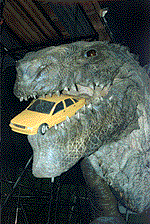Spotlight : August 1998
Patrick Tatopoulos: The Man Behind The Monster
PART TWO
Written By Scott Essman
Spotlight : August 1998
Patrick Tatopoulos: The Man Behind The Monster
PART TWO
Written By Scott Essman
In December 1996, a 20,000 square-foot facility in Culver City in which the
various practical aspects of the character were to be created was established as "the Godzilla shop." Tatopoulos, who was assigned to supervise the look of the CG animation as well, had to quickly assemble a team of top-notch sculptors, moldmakers, suit fabricators, art directors and production coordinators required to undertake the mammoth proportions of the show. "I was lucky since, at that time, Stan Winston was wrapping THE LOST WORLD, and Rick Baker was completing MEN IN BLACK, so the craftspeople who finished working in those shops were able to come to my new shop. At its peak, my crew, with 172 members, was the biggest ever assembled," he recalled.
After many discussions with director Roland Emmerich, the original plan for
the numerous character effects was to split the film 50%-50% between Tatopoulos practical creatures and CGI. "Roland had just put together Centropolis Effects, his own CGI company," explained Tatopoulos, "so it was only natural that he wanted GODZILLA to put them on the map." Acknowledging CGI as another
Upon forming his core team, Tatopoulos set out to create two scales of
Godzilla in his shop: an articulated suit worn by a performer, and an oversize mechanical character operated by a team of puppeteers. "We decided that the suit-size creature would be 1/24-scale and used for action shots with the same scale model buildings," said Tatopoulos. "However, we felt that it would be too small for insert shots and closeups, so we agreed to build a 1/6-scale, 35-foot-tall, hydraulic creature from the hips up." Added to this task was an extensive sequence involving Godzilla's offspring, the babies, or baby-zillas, for which Tatopoulos team would need to create eight suits and a ninth hydraulic creature. "We had so many different items to build in such a short period, it was like working on five films at once!" said mechanical supervisor Guy Himber.
Under Jake Garber, supervisor of the shop's art department, James Kagel
coordinated the sculpting crew who worked from Tatopoulos' baby-zilla designs, all similar to prevent a continuity headache. "We created eight babies to take the part of 250," Tatopoulos noted. "My concept was generic so they could be interchangeably used in the film." Dave Kindlon designed the baby- zilla heads, with radio-control servos and custom motors built onto lightweight carbon-fiber frames. The heavy foam latex suits were fabricated with spandex undersuits to make them more resistant, and special leg extensions helped the babies achieve predatory snapping motions when puppeteered. "We had months of training; first we studied videotapes of lizards, iguanas and other reptiles to get a feel for how they moved," Tatopoulos explained.
"Roland and I tested acrobats and stunt people from Cirque De Soleil to wear the baby-zilla suits." The performer entered the suit from behind, fitting into the arms and legs from an open back. Next, the creature's head, spine, and tail attached like a giant backpack. Lastly, the actor was outfitted with leg extensions - towards the end of shooting, it became pragmatic to attach the leg extensions before the backpack - and finally the hands went on like gloves. On set, in addition to the suit performer, each baby had two puppeteers to actuate facial movements, plus a dresser to help the performer into the suit. Three hero babies featured articulated tongues and nictitating membranes on their eyes, while background babies were capable of simple mouth, eyelid and eye movements. A ninth completely hydraulic one designed by Tim Ralston was able to achieve more quick actions and possessed abilities such as breathing and tail motion. "The fully hydraulic baby was on a motion base from the waist up," Guy Himber explained. "A company called Mediamation provided a computer control and recording system to puppeteer it with the ability to repeat specific movements."
Back to the Spotlight Main Menu
"It was basically my version of GODZILLA - the way I think it should be now,"
recalled Patrick Tatopoulos of his original creature design. "For years, people have seen Godzilla in movies, but I wanted to show them something new." That he did, and once Toho Studios had approved of Tatopoulos' new Godzilla designs, the artist was faced with the challenge of creating a believable monster who
was to appear 350 feet tall as it romped around Manhattan. "GODZILLA was definitely my biggest project," Tatopoulos admitted. "I felt that a lot of the responsibility was on my shoulders since we were creating the title character."

Patrick Tatopoulos (at right) poses with the 1/6 scale Godzilla.
filmmaking tool, Tatopoulos noted its necessity in a project with as many dimensions as GODZILLA. "Even though I'm not as huge a fan of CGI as I am of practical effects, the only thing I'm concerned about is using the technique that works best for the situation " he said. "Ultimately, as a designer, I care about having a character that looks good throughout the whole movie."

The animatronic beast with a taxi in its jaws, for the climax of the film.

. . VFX HQ Produced by Todd Vaziri . . http://www.vfxhq.com . . e-mail: tvaziri@gmail.com . .
All text Copyright © 1998 Todd Vaziri, unless otherwise noted